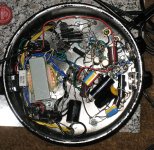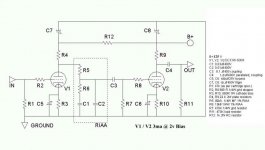The RJM Audio website has moved. The information on the 6DJ8 phono project can be found here.
RJM Audio is me. The design of this phono stage is my own, in the sense that I worked out and simulated the RIAA values for the circuit, the operating points for the tubes etc. The "two triodes, passive filter, no feedback" phono circuit is generic and goes way back.
RJM Audio is me. The design of this phono stage is my own, in the sense that I worked out and simulated the RIAA values for the circuit, the operating points for the tubes etc. The "two triodes, passive filter, no feedback" phono circuit is generic and goes way back.
I always wanted to try this just for sheer simplicity
http://margo.student.utwente.nl/el/tubes/schema/preamp/fb-e180f.gif
Has anyone built and listened critically to this circuit? Is it worthwile and has anyone improved its performance with CCS etc?
Regards,
JA
Has anyone built and listened critically to this circuit? Is it worthwile and has anyone improved its performance with CCS etc?
Regards,
JA
Well, the simplicity is nice, but it is very old school, were the pros and cons of NFB was not clear (are they clear these days?). Though I admit it is tempting b/c of it's simplicity, and since the NFB is only around a single stage, perhaps it is not so 'bad' after all. Most people prefer passive RIAA networks. I'd go for the RJM circuit.
being new to this, how easy would this be to build?
Easy enuff to be a first project😉
Here's mine.....A fun little Project that keeps on Giving.
6DJ8 Phono Amp Diagram - AudioKarma.org Home Audio Stereo Discussion Forums
6DJ8 Phono Amp Diagram - AudioKarma.org Home Audio Stereo Discussion Forums
Hey rjm..Still Listening to and Loving your 6DJ8 Phono Amp..I'm running Ruskie 6N23P-E tubes in it now, which sound Great..It only took 10 of them to find 3 Good Ones...My question is about R5...I tried a Variable Resistor, but that was a Real Pain...A Tiny Screwdriver, Close Caps..Etc..So, I just put in (2) 82.5Ks and it sounded nice...But, it seemed a bit Bass Lite...So now, I just put in 113K's, and it sounds Bass Beefier...So now, my B+ is only 135V and I was wondering if you could tell me how R5 effects the tone as far as B+ being higher or lower, and what's a Good Range for the R5s?
Here's how it looks now...
Oh, by the way, I listen to this with a Stanton 681EEE with a D74S stylus...So, the Higher End is Very Nice...
Here's how it looks now...
Oh, by the way, I listen to this with a Stanton 681EEE with a D74S stylus...So, the Higher End is Very Nice...
Attachments
Last edited:
I found this thread searching for info because I want to build your phono stage .I bought a pcb from stereo 24 in poland but I want to know if I can use these values of the components mentioned on this schematic but for 6N1P tubes? Can you advice?The RJM Audio website has moved. The information on the 6DJ8 phono project can be found here.
RJM Audio is me. The design of this phono stage is my own, in the sense that I worked out and simulated the RIAA values for the circuit, the operating points for the tubes etc. The "two triodes, passive filter, no feedback" phono circuit is generic and goes way back.
Attachments
The 6N1P is not the same as a 6DJ8 or ECC88.
6N1P has similar gain to a 6DJ8, but its anode resistance is higher and its transconductance is lower.
You could build that circuit using 6N1P tubes using the same parts values and it would most likely 'work'. The EQ might be a bit off, though.
You would need to tweak the circuit to get the correct RIAA EQ and best performance out of those 6N1P triodes.
6N1P has similar gain to a 6DJ8, but its anode resistance is higher and its transconductance is lower.
You could build that circuit using 6N1P tubes using the same parts values and it would most likely 'work'. The EQ might be a bit off, though.
You would need to tweak the circuit to get the correct RIAA EQ and best performance out of those 6N1P triodes.
Can you advice on these tweaks?The 6N1P is not the same as a 6DJ8 or ECC88.
6N1P has similar gain to a 6DJ8, but its anode resistance is higher and its transconductance is lower.
You could build that circuit using 6N1P tubes using the same parts values and it would most likely 'work'. The EQ might be a bit off, though.
You would need to tweak the circuit to get the correct RIAA EQ and best performance out of those 6N1P triodes.
I haven't looked closely at this circuit, but you would probably need to adjust the values of the anode resistors (R4, R9) and cathode resistors (R3, R10) to bias the tubes, and also adjust the value of R5 (and possibly C2) to correct the response of the RIAA EQ filter for the higher internal anode resistance of the 6N1P.
Can you calculate the component values you mention of this schematic for using 6N1P? I cannot by myself
It would be easier to get a pair of ECC88 / E88CCThe 6N1P is not the same as a 6DJ8 or ECC88.
6N1P has similar gain to a 6DJ8, but its anode resistance is higher and its transconductance is lower.
You could build that circuit using 6N1P tubes using the same parts values and it would most likely 'work'. The EQ might be a bit off, though.
You would need to tweak the circuit to get the correct RIAA EQ and best performance out of those 6N1P triodes.
I have run a simulation of the RJM-circuit with 6N1P instead of ECC88 and no other changes in component values.
It seems alright to me, so why not just try?

It seems alright to me, so why not just try?
I forgot to mention, that the above simulation assumes that the B+ is 250 V as in the original circuit.ok herrmann thank you for the answer, I will try as you propose and post some results
Yes it is obvious, nothing else to change?? any suggestion for the capacitors ?
regarding the caps I chose these
WIMA FKP-2 Polypropylene Capacitor 5mm 630V 10nF 2.5%
WIMA FKP-2 Polypropylene Capacitor 5mm 630V 10nF 2.5%
MUNDORF MCAP Capacitor 630V 0.1µF
JANTZEN AUDIO STANDARD Z-CAP Capacitor 400V 1μF
NICHICON KW Electrolytic Audio Capacitor 50V 100μF
JANTZEN AUDIO CROSS-CAP Capacitor 400V 10µF
regarding the caps I chose these
WIMA FKP-2 Polypropylene Capacitor 5mm 630V 10nF 2.5%
WIMA FKP-2 Polypropylene Capacitor 5mm 630V 10nF 2.5%
MUNDORF MCAP Capacitor 630V 0.1µF
JANTZEN AUDIO STANDARD Z-CAP Capacitor 400V 1μF
NICHICON KW Electrolytic Audio Capacitor 50V 100μF
JANTZEN AUDIO CROSS-CAP Capacitor 400V 10µF
All OK, as I see it. I take it that you are getting the 30 nF caps by using three caps with value 10 nF in parallel?Yes it is obvious, nothing else to change?? any suggestion for the capacitors ?
regarding the caps I chose these
WIMA FKP-2 Polypropylene Capacitor 5mm 630V 10nF 2.5%
WIMA FKP-2 Polypropylene Capacitor 5mm 630V 10nF 2.5%
MUNDORF MCAP Capacitor 630V 0.1µF
JANTZEN AUDIO STANDARD Z-CAP Capacitor 400V 1μF
NICHICON KW Electrolytic Audio Capacitor 50V 100μF
JANTZEN AUDIO CROSS-CAP Capacitor 400V 10µF
Looking forward to your report on the finished product.
- Home
- Amplifiers
- Tubes / Valves
- RJM 6DJ8 phono section

